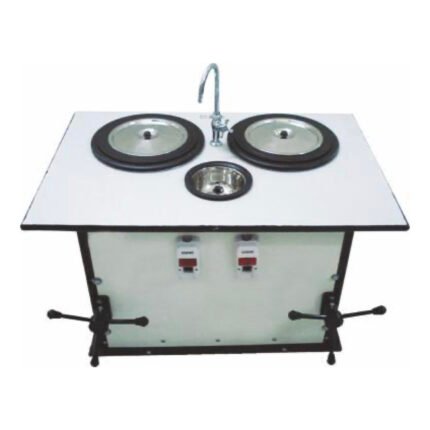AZA 1013 CHARPY IMPACT TESTER
- AZA 1013 Charpy Impact Tester: Measures material toughness and resistance to brittle fracture.
- Pendulum-type tester with robust construction for stability.
- Available with high-resolution analog or digital energy display.
- Complies with key Indian (IS 1757) and International (ASTM E23, ISO 148-1) standards.
- Essential for quality control of metals, alloys, and critical components.
- Features precise hammer, anvils, and safety braking system.
- Helps assess ductile-to-brittle transition temperature.
Description
AZA 1013 Charpy Impact Tester: Assessing Material Toughness and Brittleness by Azalab
The Azalab AZA 1013 Charpy Impact Tester is a vital laboratory instrument designed for accurately determining the impact strength or toughness of various materials, particularly metals and alloys. This test is crucial for understanding a material’s behavior under high strain rates and its susceptibility to brittle fracture, especially at low temperatures or under sudden shock loads. Unlike static tests like tensile or hardness tests, the Charpy impact test provides insights into a material’s ability to absorb energy before fracture, a critical property for components subjected to dynamic forces in service. The AZA 1013 offers a robust and reliable solution for quality control, material development, and failure analysis in metallurgical industries, manufacturing, and academic institutions across India.
The Science of Impact with the AZA 1013 Charpy Impact Tester
The Charpy impact test, also known as the Charpy V-notch test, is a standardized high strain-rate test that measures the energy absorbed by a notched specimen during fracture. The principle involves:
- Specimen Preparation: A precisely machined rectangular specimen with a V-notch (or U-notch, as per standard) is prepared.
- Placement: The specimen is placed horizontally on the anvils of the AZA 1013 Charpy Impact Tester, centered with the notch facing away from the pendulum.
- Pendulum Release: A heavy pendulum of known mass and length is released from a pre-determined height, allowing it to swing down and strike the specimen directly behind the notch.
- Energy Absorption: The specimen fractures, absorbing some of the kinetic energy of the pendulum.
- Energy Measurement: The pendulum continues its swing to a maximum height after fracturing the specimen. The difference between the initial potential energy and the final potential energy of the pendulum indicates the energy absorbed by the specimen during fracture (measured in Joules). A material’s ability to absorb energy before fracturing is a direct measure of its toughness. Materials with high impact strength can withstand sudden blows or shock loads without breaking, while brittle materials absorb little energy and fracture easily. This test is particularly important for assessing the ductile-to-brittle transition temperature (DBTT) in steels.
Robust Design and Precision for Accurate Testing: The AZA 1013 Charpy Impact Tester is engineered for durability, accuracy, and safe operation:
- Heavy-Duty Pendulum: Features a precisely calibrated heavy pendulum that ensures consistent energy delivery during impact.
- Robust Frame: Constructed with a rigid, stable, and heavy-duty frame to absorb impact forces without significant vibration, ensuring measurement accuracy.
- Standard Anvils & Supports: Equipped with precisely machined anvils and specimen supports that conform to international standards, ensuring proper specimen placement and reproducible test conditions.
- Braking System: A safety braking system is integrated to quickly and safely stop the pendulum after a test.
- Energy Readout: Available with either a high-resolution analog dial for direct energy reading or an advanced digital display system for precise numerical readouts, often including peak energy, angle of swing, and averaging capabilities.
- Automatic Pendulum Release (Optional): Some models may feature an automated release mechanism to eliminate operator variability.
- Safety Guards: Equipped with clear safety guards to protect the operator from flying debris during specimen fracture.
- Ease of Calibration: Designed for straightforward calibration to maintain measurement accuracy over time.
Key Features for Enhanced Performance:
- High Energy Capacity: Available in various energy capacities (e.g., 300 Joules for metals, 25 Joules for plastics, etc.), catering to a wide range of materials and applications.
- Low Friction Design: Precision bearings and a well-balanced pendulum minimize friction losses, ensuring that the measured energy is accurately attributed to the specimen’s fracture.
- Versatile Specimen Support: Can typically accommodate both Charpy (horizontal) and sometimes Izod (cantilever) specimens with appropriate anvils/fixtures (optional).
- User-Friendly Operation: Simple and intuitive operation makes it suitable for both experienced technicians and educational purposes.
Applications and Standards Compliance in the Indian Context: The Azalab AZA 1013 Charpy Impact Tester is an indispensable tool in various sectors in India and globally, particularly where material toughness is critical:
- Metallurgical Industry: For testing steels, cast irons, and non-ferrous alloys.
- Automotive & Railway: Components exposed to dynamic loads and varying temperatures.
- Construction: Structural steels, rebar, and pipeline materials.
- Power Generation: Components in turbines, pressure vessels, and nuclear power plants.
- Research & Development: Studying material behavior, effects of heat treatment, welding, and environmental conditions on toughness.
- Quality Control: Ensuring incoming raw materials and finished products meet specified impact resistance requirements. The AZA 1013 is designed to conduct tests in strict compliance with leading national and international standards, ensuring result reliability and comparability:
- IS 1757:1988 (Reaffirmed 2018): Indian Standard Method for Charpy Impact Test (for Metallic Materials).
- IS 3766:1977 (Reaffirmed 2003): Indian Standard for Dimensions for Impact Test Specimens for Metals.
- ASTM E23: Standard Test Methods for Notched Bar Impact Testing of Metallic Materials.
- ISO 148-1: Metallic materials – Charpy pendulum impact test – Part 1: Test method.
Azalab’s Commitment to Quality and Precision: Azalab is dedicated to providing high-quality, precise laboratory and industrial equipment that supports critical material characterization and quality control. The AZA 1013 Charpy Impact Tester reflects our commitment to innovation, accuracy, and user satisfaction. We understand the paramount importance of reliable impact data in ensuring product performance and safety, especially for components operating under dynamic loads. Our instruments are engineered to meet the stringent demands of modern testing laboratories in India and globally, backed by comprehensive customer support and service.
Further Information and Resources: For detailed operational procedures, specific specimen preparation guidelines, and environmental conditioning requirements (e.g., low-temperature testing), users should refer to the product manual, relevant industry standards, and consult with Azalab’s technical support team.
Specifications:
- Model: AZA 1013
- Tester Type: Pendulum Type Charpy Impact Testing Machine
- Principle: Measures absorbed energy during specimen fracture.
- Capacity (Energy Range): Available in various capacities (e.g., 300 Joules for metals, 25 Joules for plastics, other ranges as per specific model).
- Energy Readout:
- Analog Model: Large, high-resolution circular scale.
- Digital Model: Digital display for direct energy readout, angle of swing, average values.
- Pendulum Release: Manual release lever (some models may offer automated release).
- Striking Velocity: Typically around 5.2 m/s for Charpy test.
- Hammer: Hardened steel hammer with a precisely ground knife edge.
- Anvils: Hardened steel anvils conforming to standard dimensions.
- Braking System: Efficient braking mechanism for safety.
- Safety: Protective safety guard/enclosure.
- Construction: Robust, heavy-duty cast iron or steel frame.
- Leveling: Adjustable leveling screws.
- Power Supply: Not required for mechanical operation (for digital display, 230V AC, 50/60 Hz, Single Phase).
- Dimensions (Approx.): [H x W x D, e.g., 1000 x 500 x 800 mm].
- Weight (Approx.): [e.g., 150-250 kg, varies by capacity].
- Standards Compliance: IS 1757, IS 3766, ASTM E23, ISO 148-1.
- Country of Origin: Made in India.
- Optional Accessories: Specimen notching machine, low-temperature bath, standard test blocks for verification.
FREQUENTLY ASKED QUESTIONS (FAQ):
- Q: What is the main purpose of the AZA 1013 Charpy Impact Tester?
- A: It’s used to measure a material’s toughness or impact strength, particularly its resistance to brittle fracture under dynamic loading.
- Q: What is a Charpy V-notch specimen?
- A: It’s a precisely machined rectangular material sample with a V-shaped notch in the center, which serves to concentrate stress during impact.
- Q: Does the AZA 1013 come with an analog or digital display?
- A: It can be configured with either a high-resolution analog dial or an advanced digital display for energy readout.
- Q: What industries primarily use Charpy impact testing?
- A: Industries dealing with metals and alloys in applications involving dynamic loads, such as automotive, aerospace, railway, construction, and power generation.
- Q: What are the key standards the AZA 1013 complies with?
- A: It complies with major standards like IS 1757, IS 3766, ASTM E23, and ISO 148-1.
- Q: Can it test materials at low temperatures?
- A: While the machine itself operates at ambient temperature, the specimens can be pre-conditioned in a low-temperature bath and then quickly transferred to the tester for impact testing, as per standard requirements for DBTT.
Additional information
| Model |
AZA 1013 |
|---|---|
| Tester Type |
Pendulum Type Charpy Impact Testing Machine |
| Principle |
Measures absorbed energy during specimen fracture. |
| Anvils |
Hardened steel anvils conforming to standard dimensions. |
| Braking System |
Efficient braking mechanism for safety. |
| Safety |
Protective safety guard/enclosure. |
Related products
AZA 1009 HYDRAULIC COMPUTERIZED UTM
- AZA 1009 Hydraulic UTM: High-capacity Universal Testing Machine.
- Servo-hydraulic system for precise force and displacement control.
- Computerized control with comprehensive software.
- Tests tensile, compression, bending, and shear strength.
- Complies with ASTM and ISO standards.
- Essential for testing large metallic specimens, concrete, and structural components.
- Robust and reliable for demanding industrial applications.
- Available in various force capacities
AZA 1010 TORSION TESTING MACHINE
- AZA 1010 Torsion Testing Machine: Measures material response to twisting forces (torque).
- Determines torsional strength, shear modulus, and ductility in torsion.
- Features high-precision torque transducer and angle encoder.
- Digital display for real-time torque and angle of twist readings.
- Complies with ASTM E143, ASTM A938, ISO 7881 standards.
- Essential for testing shafts, wires, fasteners, and other components under shear.
- Robust construction with versatile gripping system.
- Available in various torque capacities and test modes.
AZA 1011 ROCKWELL HARDNESS TESTER
AZA 1012 BRINELL HARDNESS TESTER
- AZA 1012 Brinell Hardness Tester: For accurate Brinell hardness measurement.
- Robust design for reliable testing.
- Wide force range and standard indenters.
- Available with optical or digital indentation measurement.
- Complies with IS 1500, ASTM E10, and ISO 6506-1.
- Essential for quality control of metallic materials.
- Suitable for testing non-homogeneous materials and large components.
AZA 1014 FATIGUE TESTING MACHINE
- AZA 1014 Fatigue Testing Machine: Evaluates material resistance to cyclic loading.
- Predicts component service life and prevents fatigue failures.
- Features precise cyclic load application and high-frequency operation.
- Advanced digital control and comprehensive data analysis software.
- Complies with international standards like ASTM E466 and ISO 1143.
- Essential for R&D, quality control, and failure analysis in various industries.
- Robust construction ensures reliable and repeatable fatigue test results.
- Available with various load capacities and test modes (axial, bending, torsion).
AZA 1015 TENSILE TESTING MACHINE
- AZA 1015 Tensile Testing Machine: Advanced UTM for material characterization.
- Precisely measures tensile strength, yield strength, and elongation.
- Features high-precision load cell and digital control.
- Variable crosshead speeds for diverse material testing.
- Complies with major standards: IS 1608, ASTM E8, ISO 6892, etc.
- Includes user-friendly software for data analysis and reporting.
- Essential for quality control, R&D, and failure analysis across industries.
- Robust construction ensures reliable and repeatable results.
AZA 1017 DOUBLE DISC POLISHING MACHINE
- AZA 1017 Double Disc Polishing Machine: For superior metallurgical specimen finishing.
- Features two independent polishing discs for efficiency.
- Individual variable speed control for optimal results.
- Robust, corrosion-resistant construction with integrated water cooling.
- Achieves mirror-like, scratch-free surfaces for microstructural analysis.
- Essential for quality control, R&D, and failure analysis in materials industries.
- Enhances efficiency and reproducibility in sample preparation.
AZA 1018 SPECIMEN MOUNTING PRESS
- AZA 1018 Specimen Mounting Press: Essential for metallographic sample preparation.
- Robust manual hydraulic press for hot mounting.
- Features integrated electrical heating (up to 200°C) and water cooling.
- Digital temperature control for precise curing.
- Compatible with various interchangeable mold sizes (e.g., 25mm, 30mm, 40mm).
- Ensures consistent, void-free, and perfectly shaped mounts.
- Crucial for quality control, failure analysis, and research in materials science.

 Rock
Rock Aggregate
Aggregate Cement
Cement Concrete
Concrete Soil
Soil Steel
Steel Bitumen/Asphalt
Bitumen/Asphalt Security Survey Equipment
Security Survey Equipment General Items
General Items









